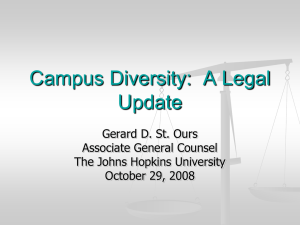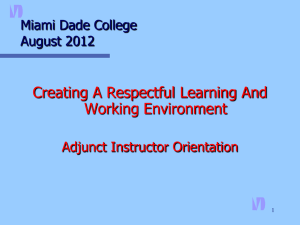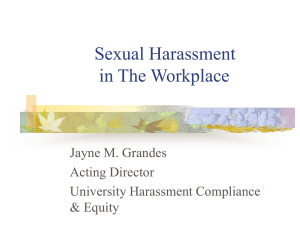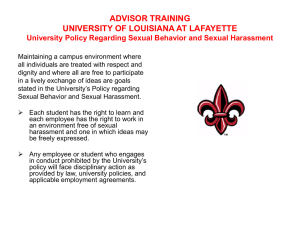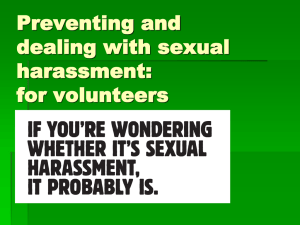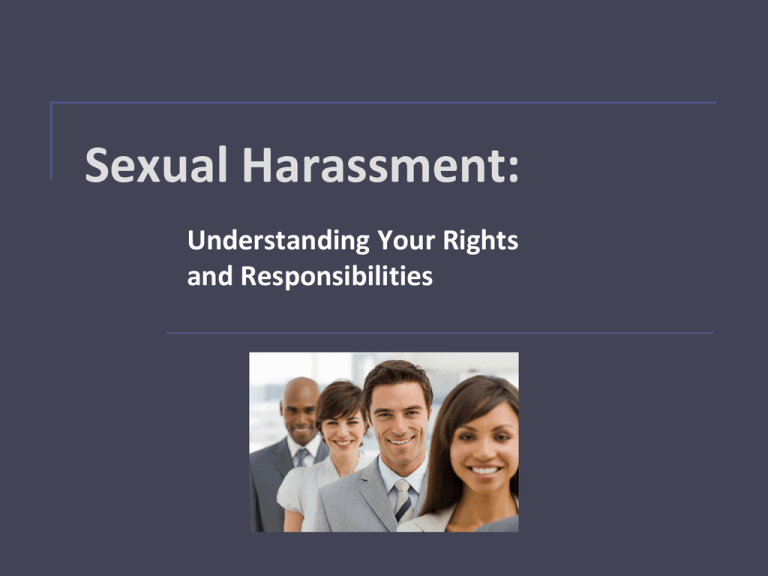
Sexual Harassment:
Understanding Your Rights
and Responsibilities
Welcome
Welcome to South Puget Sound Community
College’s web-based training on
"Sexual Harassment: Understanding Your Rights
and Responsibilities."
Objectives
Define sexual harassment
Identify a variety of behaviors that could result in
sexual or work place harassment
Recognize ways to minimize risks
Describe the college’s policies and procedures
regarding sexual harassment
SPSCC's Policy on Sexual Harassment
This training is for all college employees.
The college’s policy is to help everyone
understand and comply with the policy
prohibiting sexual harassment.
As a starting point, you will need to review The
college’s Policy on Sexual Harassment.
Basic Facts
Here are some basic facts about
sexual harassment:
Anyone — faculty, staff, administrator or student — can be a
victim of sexual harassment, and anybody can be a harasser.
Sexual harassment victims can be male or female, and so can their
harassers. A man can sexually harass another man, and a woman
can sexually harass another woman.
In the workplace, conduct would be considered sexual
harassment if it's unwelcome, based on a person's sex, and
interferes with that person's ability to do his or her job.
In an educational setting, it's pretty much the same, except that
the sexual harassment would interfere with the student's ability
to get an education.
What is Harassment ?
Harassment falls into three groups
1.
Verbal - which includes words said, written or inappropriate sound
2.
Physical - include hitting, pushing, blocking someone's way or
inappropriate touching
3.
Visual - include calendars, pictures, and inappropriate objects that can
be clearly seen
Harassment is behavior which has the effect of humiliating, intimidating, or
coercing someone through personal attack. It is behavior that will make
someone uncomfortable or embarrassed, and cause emotional distress. It
frequently occurs when one person wants to exert power or control over
another person.
Harassment may be intentional with a person targeted personally, or it
may be unintentional. What matters is how the person receiving the
behavior perceives it to be.
What is Sexual Harassment?
The Equal Employment Opportunity Commission's
definition of sexual harassment in the workplace:
Unwelcome sexual advances, requests for sexual favors, and other verbal,
visual or physical conduct of a sexual nature constitute sexual harassment
when:
Submission is made either explicitly or implicitly a term or condition of
the victim's employment; or
Submission to (or rejection of) the conduct is used as a basis for
employment decisions affecting that individual; or
The conduct has the purpose or effect of unreasonably interfering
with the victim's work performance or creates an intimidating, hostile
or offensive working environment.
These concepts and standards also apply to students in an educational
setting, and we'll try to make their meaning more clear as we go along.
Types Of Sexual Harassment
There are two basic types of unlawful sexual
harassment:
Quid Pro Quo Sexual Harassment
Hostile environment sexual harassment
Both involve unwelcome conduct of a sexual or
gender-related nature.
Quid Pro Quo Sexual Harassment
Quid pro quo is a Latin term that means “this for that"
or an exchange of one thing for another.
In the workplace, quid pro quo sexual harassment
essentially means requesting or demanding sexual favors
of some kind in exchange for special treatment on the job.
Or it could mean the threat of poor treatment if the
victim will not consent to sexual favors. The "sexual
conduct" may be verbal, visual or physical, and the
"requesting" may be done either openly or may be
implied.
But, in any case, it must be unwelcome.
Quid Pro Quo Sexual Harassment
For students, quid pro quo harassment occurs if a
college employee directly or indirectly requires a
student to submit to sexual conduct:
1) in order to participate in a college class,
program or activity, or
2) uses it as the basis for an educational decision,
such as a good grade or
a reference.
Quid Pro Quo Sexual Harassment
For both employee and for students, the
harassment is unlawful.
It is not necessary for the victim to say “no” as a
victim may give in and say “yes” to advances for fear
of being harmed in some way.
Or a victim may object and then be harmed in some
way.
Either way, it is still considered sexual
harassment.
Examples of Quid Pro Quo
Sexual Harassment:
A supervisor lets a subordinate know
that he/she will be laid off unless he/she
gives in to the supervisor's invitations to
activities outside of work.
A supervisor suggests that he/she can help a subordinate
get a promotion if the subordinate gives in to the
supervisor's advances.
A professor implies that if a student engages in sexual
activity with him or her, the student will get a better
grade.
Hostile Environment Harassment
In the workplace, hostile environment sexual
harassment takes place when speech or
conduct of a sexual nature is so severe,
persistent or pervasive that it interferes with
an employee’s work performance, or creates
an intimidating, hostile, or offensive working
environment.
Hostile Environment Harassment
For students, this type of sexual harassment occurs
when a college student's or employee's speech or
conduct is sexual in nature and is so severe,
persistent or pervasive that it limits a student's
ability to participate in or benefit from an
educational activity or program, or creates a
hostile or abusive educational environment.
Hostile Environment Harassment
Hostile environment harassment may also include
intimidating or harassing conduct of
a non-sexual nature that is directed at an individual
(or group of individuals) because
of his/her/their gender.
Examples Hostile Environment Harassment
Talking about sex or making remarks about another person’s
sexual activity (i.e., dating, sexual activity or preferences)
Telling or posting sexually suggestive jokes, cartoons
or pictures
Unnecessary and/or inappropriate touching
Sexual remarks about a person’s clothing or body
Caressing, patting, pinching or giving back rubs or shoulder
“massages”
Using demeaning or inappropriate terms; e.g.,
"Honey" or "Sweetie“
Making sexually suggestive gestures
Test Your Understanding
Bob supervises a staff of ten people. He holds required staff meetings
every Thursday. For the past six months, Jake has reserved the first
ten minutes of each staff meeting for what he calls a "morale
builder," during which the staff exchanges the latest jokes. The jokes
are almost always of a sexual nature.
Tom is a member of Jake's staff. He never participates in the "morale
builders" and generally avoids them by arriving ten minutes late to
staff meetings. Jake calls Tom into his office. He tells Tom that his
habit of arriving late is unacceptable and warns him that he will
receive a written reprimand the next time he is late. Tom tells Jake
that the reason he arrives late is because he finds the dirty joke
sessions offensive. Jake just repeats his warning.
True or False: This is an example of both Quid pro Quo and
hostile environment sexual harassment.
Answer: True
This could be an example of both quid pro quo and hostile
environment sexual harassment.
Jake is essentially requiring Tom to cooperate with him in conducting
inappropriate joke sessions and has threatened him with an adverse
action (the letter of reprimand) if he doesn't cooperate. Such conduct
may be considered quid pro quo sexual harassment.
It could also be an example of hostile environment sexual harassment
because the joke sessions have occurred regularly over a period of six
months, they are offensive to Tom, and they interfere with his
attendance at required meeting.
What Is Meant By "Unwelcome"?
Behavior should be considered "unwelcome" if the recipient indicates
that the conduct is not wanted or that she/he finds it offensive. It may
also be considered “unwelcome” when the recipient does not initiate the
behavior but does not openly object or complain. The fact that the victim
has not objected or complained does not necessarily mean the conduct
is welcome.
On the other hand, if the recipient actively participates in sexual banter
without giving any indication she/he finds it offensive, it will probably be
considered welcome. But even where this may be happening, keep in
mind that some people may feel they have to "go along to get along"
and, whether they say so or not, find it objectionable.
Some sexual comments and/or advances are so blatant and crude as to
be inherently offensive: these will almost always be deemed unwelcome.
Perception Over Intention
The victim’s perception vs. the harasser’s intent.
Sexual harassment claims are generally analyzed from the
perspective of whether a “reasonable person” would find
the conduct to be offensive.
A single remark or joke will typically not result in a find of
sexual harassment. However, if you are in doubt about
whether a joke or remark is appropriate, don’t say it!
Too frequently defendants say “I did not intend to offend
the victim…” but remember the law weighs the impact on
the victim greater than your intent, so you must maintain
the highest level of conduct at work.
The Harasser's Intent Is Irrelevant
It doesn't matter whether the alleged harasser intended
to harass the victim. The conduct is evaluated from the
victim's perspective. Some offenders may be completely
unaware of how their actions are being perceived.
For example, where the victim is female, courts apply a
"reasonable woman standard," asking whether a
reasonable woman would have found the conduct in
question so severe and pervasive that it created a hostile
environment.
Test Your Understanding
Kerry worked as an admissions technician. During her initial training, she met
Sterling, another trainee. Soon after, Sterling began to pester Kerry with
unnecessary questions, hang around her desk, and pressure her to have lunch
with him alone. She consistently refused. Then he started asking her to have
drinks with him after work. Each time, Kerry put him off. One day, Sterling
handed her a note that said, "I cried over you last night and I'm totally drained
today. I have never been in such turmoil." Kerry was shocked and frightened.
She left the room, but Sterling followed, saying, "I really care for you, Kerry.
Please talk to me!" Kerry called in sick the rest of that week.
That weekend, Sterling stuck a romantic card with a three-page letter in Kerry's
home mailbox. One part of the letter said: "I really care for you and know that
you are worth knowing with or without sex. I have enjoyed you so much over
these past few months. Watching you, experiencing you from oh so far away.
I'll write again soon." Kerry became frantic and filed a grievance alleging sexual
harassment.
True or False: Sterling's actions do not constitute sexual harassment because
he really cares for Kerry and wants a relationship even if it doesn't include sex.
Answer
False
Sterling's conduct is hostile environment sexual
harassment even though he may have good
intentions. A reasonable woman would consider
his conduct severe and pervasive enough to
interfere with Kerry's job performance and create
an hostile environment.
When Does An Environment
Become Hostile?
To be hostile environment sexual harassment, not only
must the conduct be unwelcome, it must also meet two
other requirements:
• The victim must have been personally offended by the
conduct; and
• The conduct must have been so severe, persistent
and/or pervasive that a reasonable person in that
situation would have found it offensive.
Factors Considered Relevant
to whether an Environment is Hostile
The frequency and severity of the unwelcome conduct
Whether the conduct was physically threatening or
humiliating, or limited to offensive words
Whether the conduct unreasonably interfered with the
victim's work or academic performance
The effect on the victim's physical and mental well-being
In employment, whether the harasser was the
victim's supervisor
Test Your Understanding
"Staring Stanley"
Stanley has a crush on his co-worker, Lisa. He asks her for dates
several times, but she always says no. The last time Stanley asks, she
tells him she isn't interested and wants him to stop asking her out.
Although he stops asking her out, he starts watching her all the time.
He stares at her when she's at her desk. He stares at her when she
walks around the office. He seems to watch her every move. When she
catches him staring at her (and sometimes checking out her body), he
doesn't bother to look away — he just keeps looking. This goes on for
months.
Is this an example of hostile environment sexual harassment?
Answer:
Yes.
Asking someone out a few times probably would not
constitute a hostile environment. But after Lisa made it
clear that she didn't return Stanley's affections, he should
have stopped altogether instead of switching to
something many would consider even more offensive.
Repeated staring at someone can be both threatening and
humiliating and could interfere with the victim's ability to
do her job or to participate in school. While staring is not
as severe as actual touching, the frequency of the conduct
weighs in favor of finding a hostile environment.
Test Your Understanding
"Touchy Tom"
Tom is a college employee. His department has a new student
assistant, Suzi, who is an attractive, vivacious student. Tom shows
interest in her, but Suzi doesn't seem interested in him. One evening
when Tom is working late on a project, Suzi stops by after an evening
class to pick up some papers she left at her desk. As she walks by, he
stands up and grabs her, tries to kiss her, and when she protests and
attempts to get away, he fondles her and says, "Come on, you know
you want me." Suzi escapes his grasp, runs away, and is so upset that
she never returns to work in the department.
Is this an example of hostile environment sexual harassment?
Answer
Yes.
Tom's grabbing and groping of Suzi most likely would
be considered as having created a hostile
environment for her. While it only happened once,
and could not be considered frequent, the severity
of Tom's physical assault on Suzi would be viewed as
severe.
What to Do if You Believe You Are Being or Have
Been Sexually Harassed
DON'T just take it. Tell someone!
DO make a complaint. The college will take it seriously. If you're afraid, take a
friend, co-worker, or teacher with you.
Complaints involving sexual harassment by employees should be directed to
the Chief Human Resources Officer
Complaints involving sexual harassment by students should be directed to the
Vice President for Student Services
The college will investigate your complaint and take prompt, effective action
to correct the problem.
The college will not make your complaint public, but will have to tell some
people about it in order to investigate and take appropriate corrective action.
The only people who will know about your complaint are those who need to
know about it to get these things accomplished.
You may also file a complaint with the U.S. Equal Employment Opportunity
Commission (EEOC) and the Washington State Human Rights Commission.
The college will not allow anyone to retaliate against you for filing a complaint
and will take action against anyone who does.
Additional Resources
Sexual Harassment: It’s not Academic,” an online
article published by the Office for Civil Rights can
be found at
http://www.ed.gov/about/offices/list/ocr/docs/o
crshpam.html
The Equal Employment Opportunity Commission
has a "Questions And Answers" sheet on Federal
Laws Prohibiting Job Discrimination
http://www.eeoc.gov/facts/qanda.html
Mastery Test
To complete this training please download and complete
the Mastery Test. It will be kept in your personnel file in
the HR office.
Submit the completed test and
the signed statement of understanding to the
Human Resource Office
Building 28
Congratulations!
You have successfully completed the SPSCC online sexual harassment training!
Thank you~

